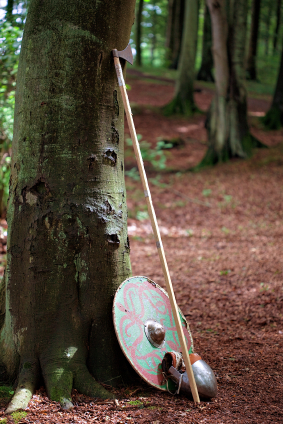
Through archaeological evidence such as Norse artifacts unearthed in Britain and written reports, historians know that there was a series of Viking invasions of Britain, particularly along the east coast, during the 9th, 10th and 11th centuries. Plus, the names of many parishes along the east coast, many of which were named during that era, have obvious Scandanavian influences; for example, in Lincolnshire up to 70% of parish names are thought to be of Scandanavian origin (often evident as a name with a -by or -thorpe suffix). Jobling and members of his lab exploited the link between surnames and Y-chromosomal DNA, both of which are passed through the paternal lineage, to help tackle the question of how much the Vikings contributed to local gene pools during these invasions.
The researchers recruited British men from West Lancashire and the Wirral peninsula to perform a pilot study, in which they characterized the participants’ Y chromosomal DNA by determining their Y-STR haplotypes. The researchers split these men into two groups: the “medieval” group and the “modern” group based on their surnames. The medieval group included men whose surnames could be traced back to British registries predating 1545; the DNA of these men represented the genetic makeup prior to the Vikings invasions. The modern group included men with surnames that had a much shorter history in Britain. The researchers also performed the same DNA analyses for Norwegian men, who represented the Norwegian Vikings in this study. Through these analyses, Jobling was able to identify Y-STR haplotypes that were more characteristic of a Norwegian population, and Y-STR haplotypes that were more common in the medieval group. He then examined the Y-STR haplotypes of the modern group and found that there was a statistically significant difference in the frequencies of certain Y-STR haplotypes in medieval and modern Britons and that the Y-STR haplotypes of men in the modern group often appeared to be an admixture of the medieval British haplotypes and Norwegian haplotypes, suggesting a higher level of Norwegian (or Viking) ancestry in modern British men.
The researchers also examined mtDNA, which is passed only through the maternal lineage, in both British and Norwegian populations. Jobling found little evidence that mtDNA sequences characteristic of Norwegian populations were present in either the medieval or modern group of British men, suggesting that men, but not women, were the source of Viking DNA in the modern group. This is consistent with the idea that Viking men participated in the long and often dangerous journeys across the North Sea to raid England but left the women at home back in Norway. In Norwegian populations, he found genetic evidence that the inheritance of male and female DNA was more equal, suggesting that the settlements in Norway consisted of males and females and, therefore, were family-based.
The results of this pilot study, which strongly support the presence of Vikings in the gene pool of Britain, have encouraged Jobling and members of his lab to expand the study to include more men in northern Britain to try to map Norwegian Viking ancestry in northern England.
So, will the results of this larger study allow me to answer my initial question as to whether my husband also might also have a little Scandanavian blood in his veins? Well, the results of these types of genetic studies are much more informative when examining a population of people rather than a single individual, so we may never know.
